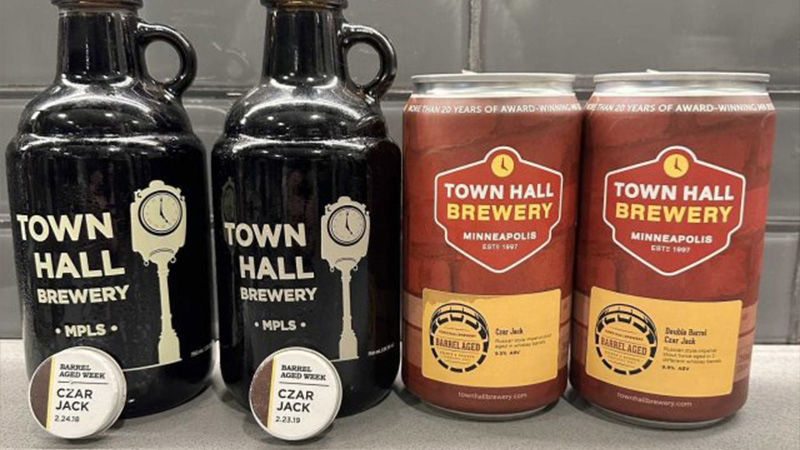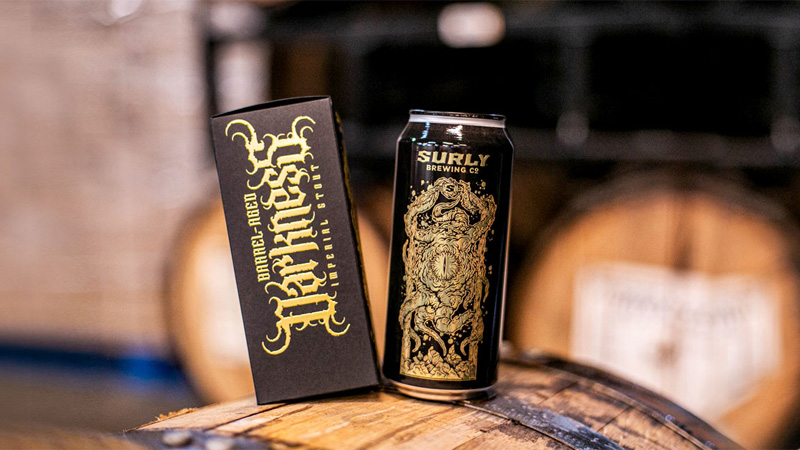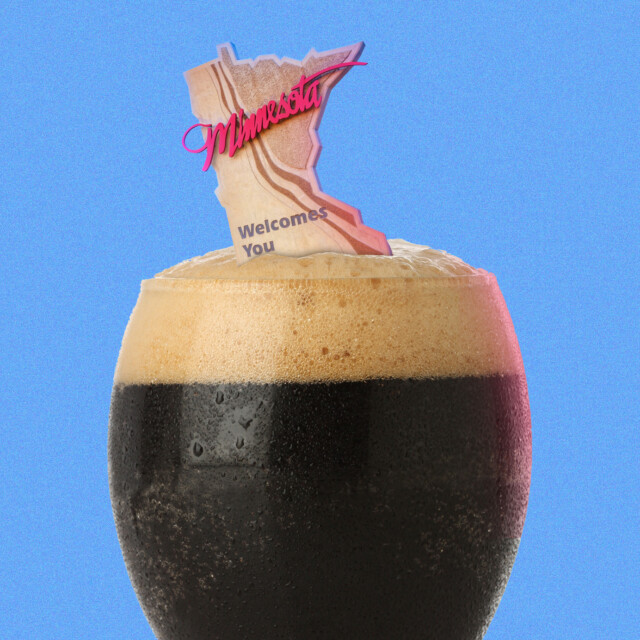It’s been an atypical March in Minnesota. Winter here is supposed to be a bleak, frigid epoch. The locals pride themselves on surviving through it, but the 2024 season has not measured up to the apocalyptic standard. Through the snowless 60-degree days, however, one boreal harbinger has remained intact: the Russian imperial stout.
Rich and complex, Russian imperial stouts are differentiated from other dark beers by both strength and apocrypha. According to Beer Judge Certification Program (BJCP) guidelines, Russian imperials should be high in ABV (8–12 percent, well-hopped (50–90 IBU), and “very dark reddish-brown to jet black.” According to a poorly cited legend, the beer was beloved by former Russian tsar Peter the Great, who first encountered it during a 1698 trip to England.
Whatever the truth of the style, Russian imperial stout became eminently popular in England and, yes, Russia, before American craft brewers began brewing their own takes on the legend. Old Rasputin, from Fort Bragg, Calif., brewery North Coast Brewing Company, is considered to be the exemplar American take on the style, but there is no locale worldwide that treasures Russian imperial stout like Minnesota.
Breweries in the Land of 10,000 Lakes like Lift Bridge Brewing, Bad Weather Brewing, and Surly Brewing rewrite Russian imperial stout’s history every year, releasing scads of these big-bodied, boozy, oversweet beers as soon as conditions turn tundra-like. Here, Russian imperial stout is cherished, shared as a resolve-strengthening show of solidarity, and hailed by the local “Star Tribune” as the “the king of beers.”
Vermont is designated territory for hazy IPAs, Montana is the land of Scotch ales, and Minnesota is the dominion of Russian imperial stout. If you open a brewery within 300 miles of the Twin Cities, you’re expected to lead with a Russian imperial stout to show the locals — customers and fellow breweries alike — your mettle. But how did this obscure, somewhat enigmatic beer become a proving ground in Minnesota — and only Minnesota?
It Starts With Jack
Mike Hoops got his beer education during a semester abroad in the United Kingdom in the early 1990s. During that trip, he sampled Baltic porters and imperial stouts, deconstructing his idea of what beer could be. After graduating, he was visiting his brother in Northern California when he first sampled Old Rasputin. The two experiences entwined in his mind, and when he finally got a job at a brewery in 2000, at Minneapolis’s Town Hall Brewery, he made those sense memories manifest in a small batch beer he called Ol’ Jack Frost.
Ol’ Jack Frost debuted in 2000, but Hoops took a portion of Ol’ Jack and threw it in bourbon barrels for 10 months. In 2001, the resultant beer, Czar Jack, was born. It was one of the first barrel-aged beers made during what would become the American craft beer revolution, a tipple that would set the standard for any beer made in Minnesota for the coming two decades. That year, Czar Jack won a gold medal at the Great American Beer Fest, winning the Experimental Beer category nine years before wood- and barrel-aged strong stout was even recognized by the competition.
“The recipe was conceived primarily to be based on the American or English style, to walk the line between both of those English and American styles,” says Hoops, now the head brewer at Town Hall. “That great, big, huge roasted character, the fruit, all that stuff needed to come forward. But it needed to have some American hop there to balance as well.”

The national acclaim was rewarding, but on the local scene, Hoops and the Town Hall team didn’t need medals or ribbons to know they’d hooked into something special with their Russian imperial stouts. It was a mix of the beer being available at the right time and in the right place. Craft beer drinkers in the nascent boom were looking for extremes, and Russian imperial stout provided wine-strength ABV, robust sweetness, and profound hop character in one beer. In the throes of a Minnesota winter, those extremes are even more welcomed.
“It just makes a logical fit with the climate that we’re dealing with,” Hoops says. “Winter is our come-together time.”
“That level of community is probably as important as the beer itself in terms of what effect that had on the craft beer scene in Minnesota.”
Town Hall continues to be a destination for barrel-aged and high-gravity beers even 23 years later. Every March, the brewery hosts Barrel Aged Week (now Weeks) to commemorate beers like Ol’ Jack, Czar Jack, and their sibling beer Russian Roulette, which won its own GABF gold itself, in the Herb and Spice or Chocolate Beer category, in 2008. But Town Hall and Czar Jack alone could not create the phenomenon that is Russian imperial stout in Minnesota.
Town Hall is limited in its impact because Minnesota law prohibits brewpubs from distributing their beer to liquor stores. While the brewpub is great for educating people on what a Russian imperial stout is and should be, conversion experiences are limited to when a customer is sat in the restaurant.
In 2006, another restaurant would spawn the Russian imperial stout that truly defined Minnesota drinking tastes. It was a little spot in Minneapolis’s Linden Hills neighborhood called Café Twenty-Eight. That year, the bistro, owned by restaurateur Linda Haug, would feature a draft-only Russian imperial stout brewed by Haug’s husband, Surly Brewing co-founder Todd Haug.
He called the beer Darkness, and though it took months to sell, the beer would catch on via word of mouth. Before long, it would usher in a tradition of Northern-made black beer — a local icon that would garner dozens of imitators, adversaries, tributes, and homages in the decades to come.
Dawn of Darkness
After kegs of Darkness ran dry at Café Twenty-Eight, folks started anticipating the 750-milliliter bottle release from Surly in December 2007. On the day that the brewery was set to release the beer, co-founder Omar Ansari arrived at the brewery’s converted warehouse in Brooklyn Center to find that crowds of people had already assembled in the cold to vye for one of the less than 600 bottles available.
Ansari brought out a keg of Surly’s coffee-infused brown ale, Coffee Bender, and ordered some Krispy Kreme doughnuts to tide over the crowd. Local metal band God Came from Space (which featured Surly’s own Sarah Lawson) took the stage. And with that meager offering, Darkness Day was born.

Ben Smith wasn’t in attendance that day, but he was a Darkness Day attendee long before he took his current role as head brewer at Surly. Most folks in the Minnesota beer industry found their way through the festivities, which grew from the apropos camp-out into the region’s most anticipated outdoor bottle share. Folks would show up with their rarest, most prized cellar fare — often imperial stouts, for the warmth they offered — and commune with strangers while bonfires burned and metal bands thrashed. Over the years, the event got bigger, and even moved to an amphitheater in Wisconsin. But it was those salad days in the industrial park where Smith says the legend of Darkness and its fondness in the hearts and livers of Minnesotans began.
“That level of community is probably as important as the beer itself in terms of what effect that had on the craft beer scene in Minnesota,” Smith, who’s been with Surly since 2013, says. “To experience that as a fan before I ever worked for Surly; I can definitely relate to how powerful and impactful that was. It really influenced my career path to become a professional brewer when I was just a homebrewer.”
“It’s a fun beer to brew, because it’s easy to put your thumbprint on a recipe. You can flex it quite a bit. It’s nothing like brewing a pilsner, where you still have to make it tight. A Russian, you can tweak that flavor a lot.”
Darkness came every year with a heavy-metal-inspired graphic painted on the front of the bottle. Surly upped the production annually, and the gnarly bottles started showing up in liquor stores across the state and throughout the Midwest, a feat Town Hall couldn’t accomplish with its business model. Hoops doesn’t mind, though. He’s a believer that Surly’s success with Darkness helped draw people into Town Hall when Ol’ Jack came ‘round.
“It was really that ‘rising tides floats all boats’ thing,” Hoops says. “The way they marketed, the quality of the beer, the event that they created, that brought in more and more people that were younger and younger to the scene.”
If 2001 was truly Russian imperial stout’s genesis as Minnesota’s flagship beer, 2007 was its exodus. In the years to come, dozens of local breweries would add a Russian to their taplists. First-wave craft hotspots like Barley John’s Brewpub (John Courage), Bent Brewstillery (Dark Fatha), Brau Brothers Brewing (Ivan the Great), and Fulton Beer (Worthy Adversary) turned the Russian imperial stout moment into a movement, and later-comers like Boom Island Brewing (Kollusion), Waconia Brewing (Driftwood), Bad Weather Brewing (Calamity), and Sisyphus Brewing (Stout Season) deepend the tradition with their own.
Each brewery’s take on the style varied meaningfully, adding to the lore. Some went for higher-IBU and drier finishes. Others leaned into the malt sweetness. Just about everyone experimented with different barrels and resting times. Inbound BrewCo uses a measure of German smoked wheat in its RIS to impart a welcoming campfire feel.
“It’s a fun beer to brew, because it’s easy to put your thumbprint on a recipe,” says Eric Biermann, Inbound’s founder and president. “You can flex it quite a bit. It’s nothing like brewing a pilsner, where you still have to make it tight. A Russian, you can tweak that flavor a lot.”
Darkness had become a gauntlet thrown down before the state’s brewers and a toolbox to pull from. The arrival of winter meant an imperial stout had to go on the brew schedule. And it became customary that the beer, whatever the modifications made, should be released in a big, boreal blowout just like Surly started.
“In the Midwest, you get used to drinking those beers, and then when you get to a place where you just open a brewery up, you want to attach yourself to that and do your own version of it.”
Lift Bridge Brewing opened in Stillwater in 2008, and when it launched the Russian imperial Silhouette a year later, the brewery led with a party. Vice president of marketing and co-founder Brad Glynn modeled his January release after Darkness Day as well as similar events from 3 Floyds and Cigar City. Silhouette, perhaps the second most popular Russian in Minnesota behind Darkness, releases every January with huge festivities. Often, the brewery hosts vertical tastings of past vintages and barrel-aged variants, an ode to the impromptu bottle sharing that sprang up at Darkness Days.
“During the winter, when you don’t have all the patios open and everyone’s drinking boat beers, you still want people drinking beer,” Glynn says. “Having tentpole-type halo beer, this imperial stout, every year, definitely became the norm for January with Silhouette.”
The annual Silhouette release is so important to Lift Bridge that Glynn has pulled the beer off liquor store shelves in Minnesota. After years in the market, the beer, and its barrel-aged variants, is only sold at Lift Bridge’s taproom, where it buoys annual traffic. Even as the American appetite for beer has turned away from European classics and toward more aggressive and confectionary beers, Glynn still sees the power in bringing people together around something that’s potent enough to still raise eyebrows.
“It’s not the biggest-selling beer in our portfolio, but it’s one of those that, as craftspeople, our brewers love putting together and blending,” Glynn says. “To see a consumer taste and give feedback immediately, it’s such a bold beer, that’s why we love doing it.”
Russian Affairs
In 2015, the BJCP updated its style guidelines to remove “Russian” from the name. Rechristened simply “imperial stout,” the change seemingly reflected what we knew all along about the style: it wasn’t Russian at all.
As a result, far fewer breweries debuted new beers with that name. The BJCP change dovetailed with increased tensions between Russia and the United States over the 2016 election and Russia’s invasion of Ukraine in 2022. Breweries were more than happy to shed the geographical signifier — even 3 Floyds redesignated Dark Lord.
Jeremy Pryes, co-founder of Minneapolis’s Pryes Brewing, knows that his Lost Moon is probably better classified as a British imperial stout, but he keeps the word as a matter of local custom. Breweries like Surly, Town Hall, and Lift Bridge worked for years to educate local drinkers about the “liquid jacket” that the beer provides.
“If it feels like nobody’s doing it, it’s because nobody calls it a ‘Russian imperial stout’ anymore,” Pryes says. “But in the Midwest, you get used to drinking those beers, and then when you get to a place where you just open a brewery up, you want to attach yourself to that and do your own version of it.”
The overall stout market has changed significantly since Ol’ Jack Frost made its millennium debut. Where once it was trendy to make minute recipe changes year to year, drinkers began demanding more novelty. Barrel-aged beers gave way to multiple batches aged in different spirit barrels. Then adjuncting took over. Now, the stouts that draw crowds are modeled after German chocolate cake and tiramisu.
As a result, the overall market for Russian imperial stout has declined. Even in Minnesota, where Surly has taken to releasing Darkness flavored to taste like s’mores and raspberry chocolate torte. Packaging sizes have shifted, as 750-milliliters began sitting on shelves. Some breweries reformatted to 4-packs of 12-ounce. beers. Others have boxed cans to try to drive down the single-serving price point while maintaining the special, once-a-year feel.
In 2024, the Russian imperial stout empire is weakened. Darkness Day went on hiatus for two years to protest Minnesota off-sale liquor laws, but the writing was on the wall for the struggling style. Russian imperial-producing breweries like Lakes & Legends Brewing, Tin Whiskers Brewing, and Clutch Brewing have closed in the past two years, shrinking the market. Inbound even took its RIS out of the rotation last year, thinking it wouldn’t be missed.
It was. Right on time, snowbound drinkers came knocking, looking for their liquid provisions. So much so that Biermann is already contemplating the 2024 batch. Minnesota may be in the midst of the warmest winter since 1877, and its keepsake beer, Russian imperial stout, feels less relevant than ever. But if there’s one thing that the folks here know, it’s to never trust a stretch of good weather.
“We still get big, huge, dark winters here, and people will be looking for something to do,” Hoops says. “And there’s nothing more fulfilling in the dead of winter than drinking a Russian imperial stout.”
